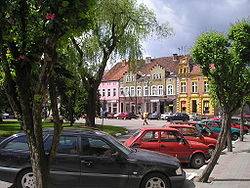Lidzbark
- Not to be confused with the larger town Lidzbark Warmiński. For other meanings, see Lidzbark (disambiguation).
Lidzbark | |
|---|---|
 Haller Town Square in Lidzbark | |
| Country | |
| Voivodeship | Warmian-Masurian |
| County | Działdowo |
| Gmina | Lidzbark |
| Area | |
| • Total | 5.7 km2 (2.2 sq mi) |
| Population (2006) | |
| • Total | 8,261 |
| • Density | 1,400/km2 (3,800/sq mi) |
| Postal code | 13-230 |
| Website | http://www.lidzbark.pl |
Lidzbark [ˈlʲid͡zbark] (German: Lautenburg) is a town with 8,670 inhabitants in the Warmia-Masurian Voivodeship in Poland. It is located on the Wel river and Lake Lidzbark. The postal code for the entire area is 13-230.
The town is popularly referred to as Lidzbark Welski, to distinguish it from Lidzbark Warmiński.
History
Lidzbark was founded in 1301. The town's Roman Catholic parish church was constructed in 1350.
Władysław II Jagiełło led his army through Lidzbark on July 9, 1410 before the Battle of Grunwald. On September 29, 1413, some of the Teutonic Knights in the town revolted against Heinrich von Plauen the Elder; they were only appeased with Plauen's replacement with Michael Küchmeister von Sternberg. In 1466 Lidzbark became part of the Polish province Royal Prussia after the Second Peace of Thorn (1466). A large portion of the city was destroyed by fire in 1764.
During the Partitions of Poland, the city became a part of the Kingdom of Prussia in 1772. During the Napoleonic Wars it was part of the Duchy of Warsaw from 1807-1815, but reverted to Prussia afterwards.
In 1772, the town had 510 inhabitants and 83 timbered buildings. Agriculture was common in the area along with crafting. In 1789, the population reached 802 of which 41 families were craftsmen.[citation needed]
In the beginning of the 20th century, the city had breweries, sawmills, iron mill, engine works and dairy products. In 1920, the area became a part of the Second Polish Republic.
The population in 1943 was 4,329. 70% of the city was destroyed during World War II.
Twinnings
- Oebisfelde, Germany
- Co op municipality: Guttau, Germany
- Sovetsk, Kaliningrad Oblast, Russia
Address of administration
- Urząd Miasta i Gminy
- 13-230 Lidzbark
- ul. Sądowa 21
- Tel.: (+48 23) 696-15-05
- Fax.: (+48 23) 696-21-07
External links
- Homepage of Lidzbark (in Polish and German)
- Data of Lidzbark (in German)

